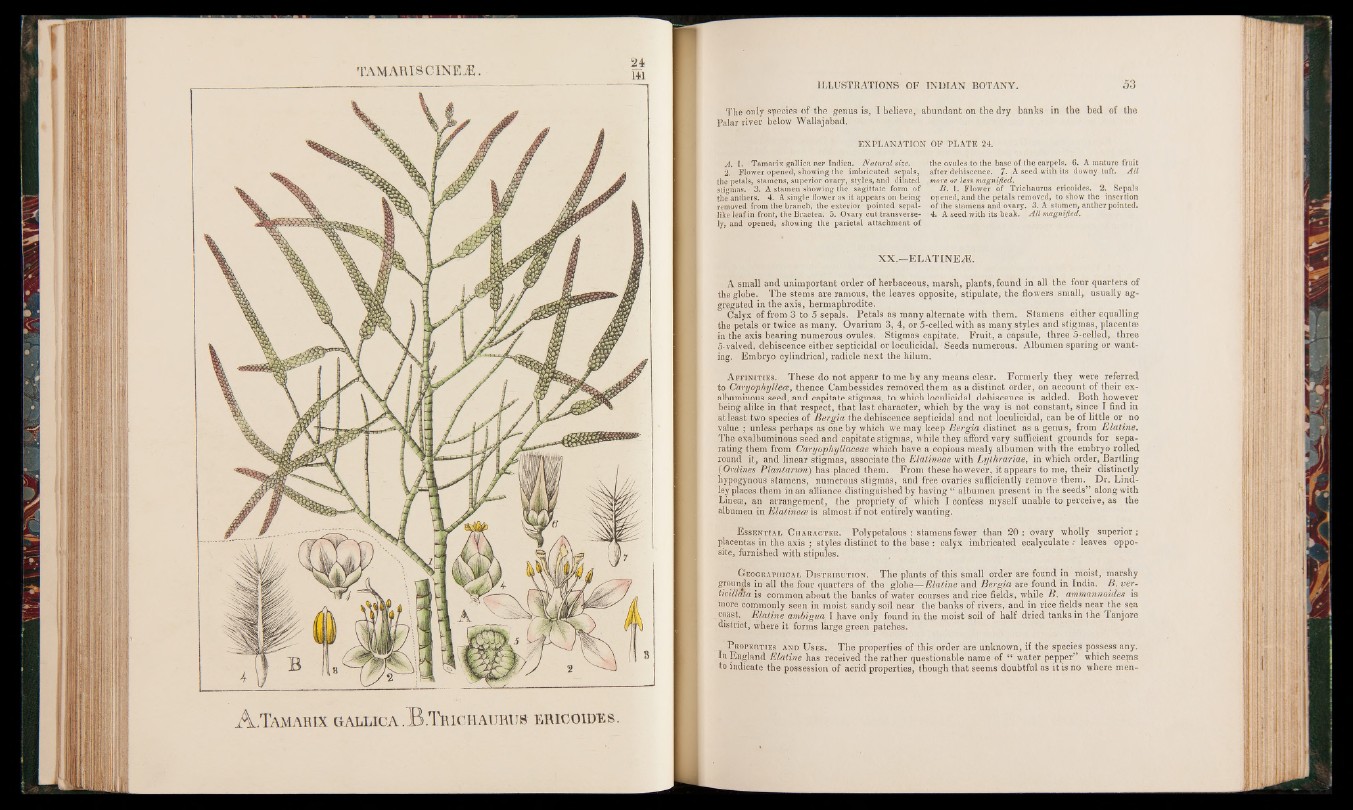
W m
TAMARIS CINEÆ.
» A ;
The only species of the genus is, I believe,-abundant on the dry banks in the bed of the
Palar river below Wallajabad.
EXPLANATION OF PLATE 24.
A. 1. Tamarix gallica var Indica. Natural size.
2. Flower opened, showing the imbricated sepals,
the petals, stamens, superior ovary, styles, and dilated
stigmas. 3. A stamen showing the sagittate form of
the anthers. 4. A single flower as it appears on being
removed from the branch, the exterior pointed sepal-
like leaf in front, the Bractea. 5. Ovary cut transversely,
and opened, showing the parietal attachment of
the ovules to the base of the carpels. 6. A mature fruit
after dehiscence. 7. A seed with its downy tuft. A ll
more or less magnified.
B . 1. Flower of Trichaurus ericoides. 2. Sepals
opened, and the petals removed, to show the insertion
of the stamens and ovary. 3. A stamen, anther pointed.
4. A seed with its beak. A ll magnified.
XX.—ELATINEA3.
A small and unimportant order of herbaceous, marsh, plants, found in all the four quarters of
the globe. The stems are ramous, the leaves opposite, stipulate, the flowers small, usually aggregated
in the axis, hermaphrodite.
Calyx of from 3 to 5 sepals. Petals as many alternate with them. Stamens either equalling
the petals or twice as many. Ovarium 3, 4, or 5-celled with as many styles and stigmas, placentae
in the axis bearing numerous ovules. Stigmas capitate. Fruit, a capsule, three 5-celled, three
5-valved, dehiscence either septicidal or loculicidal. Seeds numerous. Albumen sparing or wanting.
Embryo cylindrical, radicle next the hilum.
A ffinities. These do not appear to me by any means clear. Formerly they were referred
to Caryophyllece, thence Cambessides removed them as a distinct order, on account of their ex-
albuminous seed, and capitate stigmas, to which loculicidal dehiscence is added. Both however
being alike in that respect, that last character, which by the way is not constant, since I find in
at least two species of Bergia the dehiscence septicidal and not loculicidal, can be of little or no
value ; unless perhaps as one by which we may keep Bergia distinct as a genus, from Elatine.
The exalbuminous seed and capitate stigmas, while they afford very sufficient grounds for separating
them from Caryophyllaceae which have a copious mealy albumen with the embryo rolled
round it, and linear stigmas, associate the Elatineae with Lythrariae, in which order, Bartling
(Ordines Plantarum) has placed them. From these ho wever, it appears to me, their distinctly
hypogynous stamens, numerous stigmas, and free ovaries sufficiently remove them. Dr. Lind-
ley places them in an alliance distinguished by having “ albumen present in the seeds” along with
Linege, an arrangement, the propriety of which I confess myself unable to perceive, as the
albumen in Elatinece is almost if not entirely wanting.
E ssential C haracter. Pol ypetalous : stamens fewer than 2 0: ovary wholly superior;
placentas in the axis ; styles distinct to the base : calyx imbricated ecalyculate •• leaves opposite,
furnished with stipules.
G eographical D istribution. The plants of this small order are found in moist, marshy
grounds in all the four quarters of the globe-—Elatine and Bergia are found in India. B. ver-
ticiliata is common about the banks of water courses and rice fields, while B. ammannoides is
more commonly seen in moist sandy soil near the banks of rivers, and in rice fields near the sea
. coast. Elatine ambigua I have only found in the moist soil of half dried tanks in the Tanjore
district, where it forms large green patches.
P roperties and Uses. The properties of this order are unknown, if the species possess any.
In England Elatine has received the rather questionable name of “ water pepper” which seepis
to indicate the possession of acrid properties, though that seems doubtful as it is no where men